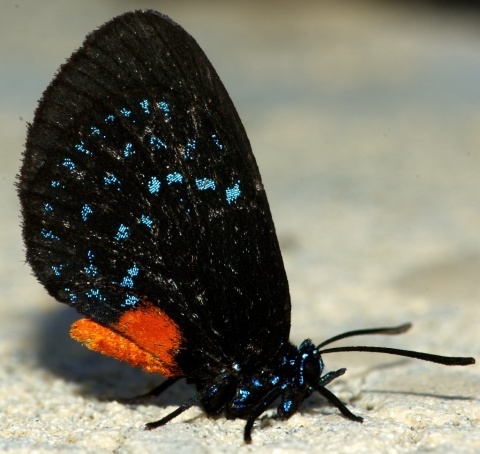I have a new puzzle on my hands. I don’t know of any places in the neighborhood with enough coontie to support the Atala Blue butterfly (Eumaeus atala), but I’ve got one “sleeping” on my pool deck:
It’s been there all morning, from 8 a.m. when I got the right profile above, to noon, when I got the left profile, below.
From now on when we’re on our evening strolls, I’ll have to keep my eyes peeled for its only known larval host plant: coontie (Zamia floridana). It’s a plant I want to have in my yard, but the seeds are poisonous, so we’re a bit worried about the boys eating them. My boys don’t have the millions of years of evolutionary adaptation that allow the butterfly larvae not only to tolerate the poison but to incorporate it into their tissues, rendering them unpalatable to predators.
The bright, warning (aposematic) coloration advertises their toxicity, so predators know to leave them alone.
Judging by the frayed wing edges and its sluggish demeanor, though, I don’t think this butterfly is much longer for this world. You have to respect its warning coloration, though: Not many insects would last four hours on that pool deck, surrounded by hungry lizards. In fact, the regal darner I “rescued” from the pool back in September didn’t last four minutes.
For more on the coontie plant and the butterfly it supports, read this information sheet from UF/IFAS.
And have a Happy Thanksgiving!



I was just now surfing to get some info on tha Atala butterfly when I came across this site. Yesterday (8-19-13) I noticed what appeared to be an Atala feeding on Joewood and Spanish Needle flowers in our garden here in Lantana. We have seven Coonties in the landscape around the house, when I gave the largest Coontie a close inspection I found about two dozen crysalises with about half hatched out. Two are very dark in color indicating they also will soon emerge. On an Avacado tree receiving late evening sun were seven adults with thier wings up. This morning one was still there. I noticed two of the coonties have some leaf damage indicating recent Atala activity.
Hi Ben,
This is very interesting. Please email me! I have been studying this insect for over 10 years. The Atala in your photo looks a little worn and I would like to compare your location to the known sites I have documented.
Thanks!